|
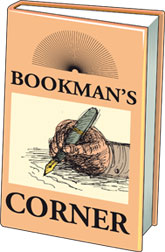
And quiet flows life...
Reviewed by Ranga Chandrarathne
Mahinda Rathnayake's novel 'Wala Yatin Mihimandalata Ira Paya' (Sun
shone through the clouds) is one of the major Sinhalese contemporary
novels.
Noted for its lengthy descriptions of both nature and incidents, the
novel navigates through a turbulent period in the contemporary
socio-economic history in Sri Lanka. Although the author's expressed
objective is to narrate the biography of his brother, the novel portrays
an up country village as vividly as never before in the Sinhala novel.
The village that Rathnayake portrays through his novel is not a
historical village at the tail end of the Sri Lankan royalty but a
contemporary village whose life has been subjected to tempests of
socio-economic changes that define the milieu.
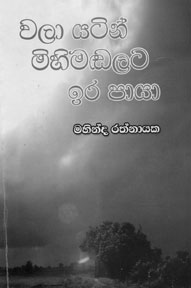 |
|
Wala Yatin
Mihimandalata Ira Paya |
The novel commences with the arrival of Malinda, an ex-university
student who engaged in radical university politics at the height of
counter insurgency operations, in the village of 'Ranamukgama' by train.
Malinda, the narrator of the story leaves behind his native village,
parents and sweetheart 'Serala' to escape from the military suppression
and to start a new life in the village Ranamukgama. Malinda joins the
leading family of the village lived in 'Ratnapaya' and soon assumes the
position of a family member.
The family saga moves on chronicling the changes that take place in
rather close-knitted community with the commencement of an
Australian-aided project through an NGO in the village. Malinda takes
the leadership in the development drive launched by the project
conserving forestry and providing alternative livelihoods for the
villagers.
The central thesis of the novel is the socio-economic transformation
of the village although the family saga occupies a prominent place in
the narration. The author, wittingly or unwittingly depicts the
overarching confluence of influence of globalisation, protracted
conflict and the counter insurgency operations at work simultaneously in
the traditional village at grassroots level. Rathnayake questions some
of the inherent weaknesses in the operational aspect of the rural
development prototype used by NGOs albeit the project is a success story
in the village.
Superb characterisation
One of the significant aspects of the novel is its superb
characterisation. For instance, the principal characters of the novel
such as Malinda, Mother and Seneviratne have been convincingly
developed. Sub-plots, stories, anecdotes which are part and parcel of
the life in the village have been well incorporated into the plot.
The author has successfully used literary techniques such as
intertexuality (story within a story), flashback and at times,
monologues to shed light on many shades of complex characters. Mahinda
Ratnayake is at his best in crafting multifarious characters.
Social network in the village with its caste and class distinctions
has been aptly described. The other important areas such as belief
systems outside the conventional religion in the village such as Davale
(temple for gods) have been discussed at length. Although Malinda, the
agent of change tries to change the primordial beliefs of the villages
and their attitudes, his attempts more or less met with failure.
Sense of place
Strong attachment of the characters to the village is depicted at
different levels; at personal level with characters such as Malinda
almost emotionally glued to the village. Sense of place (strong
emotional bondage to the village) has been established by graphic
description of the geographical contours of the village Ranamukagama and
it natural beauty.
"The Mahawa-Trincomalee railway line has been able to demarcate the
road that runs up to Galgamuwa-Moragollagama which the people described
as Tara Para at the village of Ranamukgama. The northern portion of the
four strips of land made by the crisscrossing of the railway line and
the road is separated for a hillock the villagers called Madukanda. It
is a beautiful picture but only in the rainy season....."
The descriptions such as above, reminds the reader of some celebrated
passages from Martin Wickremasinghe's Gamperaliya. Rathnayake describes
a contemporary up country village with its changing socio-economic
dynamics.
For the narration, the author has devised a unique diction which
stands out for novel use of colloquial Sinhalese idiom. However, it
should be mentioned here that the author has exercised care in the use
of standard Sinhalese for the narration.
One of the principal weaknesses of the novel is its lengthy
descriptions and a lot of sub-plots which are, at times, seem to be out
of place. Due to some of these lengthily descriptions, anecdotes, the
narration seems to take meandering course, almost loosing the focus.
Application of other literary theories
Despite its minor weaknesses, the author has been able to maintain
extremely impressive syntax and contextual clarity throughout the
narration. For instance, monologues of the characters have not clashed
with their present. Though with sub-plots, the root of the narration is
very clear and unambiguous. Ultimately it is the life in its multitudes
that Rathnayake tries to portray through the social transformation in
the nub of the village.
At a different level, it is the clash between the traditional ethos
and encroaching modernity like some of the Russian authors as Michail
Aleksandrovich Sholokhov's classic "And Quiet Flows the Don", Ratnayake
tries to capture vast canvass of life. What triumphs at the end is the
continuing hope for life.
Despite all the hardships, mother does not give up life but lives for
the others. Mother's role in the novel is one of the most evolved
characters which symbolises the ideal of sacrificial Asian mother. Minor
characters represent different social strata in the village in addition
to highlighting the different aspects of major characters.
The author has used the village as a site of change. Some of the
incidents such as extra-marital affairs in a broader perspective are the
reflections of the influence of socio-economic changes on the village.
Those characters such as soldiers, women retuned from the Middle East
acted as agents of change in their small capacities and represent the
changes outside the village.
The novel ' Wala Yatin Mihimandalata Ira Paya' stands out, among
other things, for the capturing of the milieu through a family saga in a
contemporary up country village in Sri Lanka.
Excellent Sinhalese translation of The Naked Maja
Reviewed by Ranga Chandrarathne
Watha Randi Nirupikawa, the Sinhalese translation of Samuel Edward's
novel 'The Naked Maja' is the latest translation by master Sinhalese
translator Senaratne Weerrasinghe. Watha Randi Nirupikawa marks
Weerasinghe's fifth translation of classical literary works into
Sinhalese.
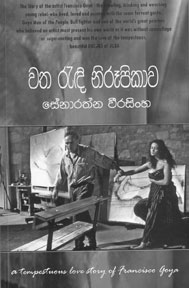 The novel 'The Naked Maja 'is based on the biography of Spanish
romantic painter Francisco Josť de Goya y Lucientes (30 March 1746 - 16
April 1828). The legendary painter, who was a Court painter to the
Spanish Crown, was both a commentator and chronicler of the era. Goya's
painting greatly influenced subsequent painter, particularly, Manet and
Piccaso. The novel 'The Naked Maja 'is based on the biography of Spanish
romantic painter Francisco Josť de Goya y Lucientes (30 March 1746 - 16
April 1828). The legendary painter, who was a Court painter to the
Spanish Crown, was both a commentator and chronicler of the era. Goya's
painting greatly influenced subsequent painter, particularly, Manet and
Piccaso.
'The Naked Maja' which was later turned into a popular film, is an
important literary production based on a biography. It, among other
things, shows how a biography can be successfully converted into a
novel. The novel raises the perennial question of what art is and what
is the role of an artist. Goya passionately believed that art is for the
service of mankind as it is the product of humanity and that it should
not used for propaganda purposes.
When Goya defied the establishment, he was incarcerated and brought
before the Court where he was questioned at length on his use of arts
particularly critical of the establishment. The name of the novel is
derived from the famous paintings of Goya entitled The Nude Maja (La
maja desnuda). It is said to be the painting of Duchess of Alba, with
whom Goya was sometimes thought to have had an affair.
Watha Randi Nirupikawa marks not only an important milestone in
contemporary Sinhalese literature in translations but also a landmark in
Weerasinghe's literary career as a gifted translator. Senaratne
Weerasinghe is one of the translators who have identified the role of a
translator. Almost all of his previous translations have been rare gems
of classical literature. The translator has tried to capture the spirit
of the original novel thereby presenting an extremely faithful
translation to the deserving Sinhalese readership. The translator has,
over the years, developed a diction which is extremely readable and
capable of overcome many a hurdles in translation.
Role of the translator
A translator plays an increasingly important role as a person who
introduces world literature or celebrated literary works to a local
readership. Through the translations, translator enriches the local
literary scene. Throughout his literary career, Senaratne Weerasinghe
has introduced to Sinhala readership a large number of classical
literary works such as Pearl S Bucks' 'Good Earth' and Charles Dickens's
'Oliver Twist'. Like a writer, a translator should also be talented so
that translated work would be a good piece of literature in the target
language. Translator should also be well versed in both languages in
this instance, English and Sinhalese to make the translation effective.
It is the translator who really made the world a universal village
through translations. If not for translators, we all could not read
Russian, French, Latin American literature and some of the great works
in world literature. When reading world literature in translations, the
question raised how closes the Russian, Englishman and Frenchman to us.
It is this closeness that brought out in introducing Colombian, Chilean,
Iranian and African literature to Sinhalese readers. Watha Randi
Nirupikawa is such an attempt by a master translator.
The reader over your shoulder
Reviewed by R. S. Karunaratne
D.C.R.A. Goonetilleke, Emeritus Professor of English, University of
Kelaniya, is one of the rare academics who is engaged in research even
after his retirement. When Kaleidoscope Volume I was published a few
years ago, I felt that there is a reader over the shoulders of all Sri
Lankan writers. Be it prose, verse, or drama, now there is a competent
person who reads what they write. He has taken upon himself the
difficult task of sifting out outstanding segments of literature.
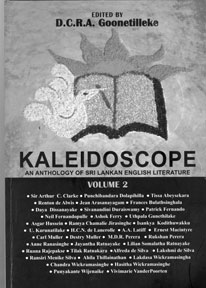 |
|
Kaleidoscope Volume 2
Author:
D.C.R.A. Goonetilleke
A Vijitha Yapa Publication |
The author has read a large volume of Sri Lankan literature to select
the best that represent contemporary English writing. With his vast
knowledge of English literature and experience gathered in teaching it
to several generations at the university, Prof. Goonetilleke is
singularly qualified to compile a book of this nature. His books on
English literature include "Developing countries in British fiction,"
"Images of the Raj: South Asia in the literature of empire," Joseph
Conrad: "Beyond culture and background", "Salman Rushdie", Joseph
Conrad's "Heart of Darkness", Sri Lankan English literature and the Sri
Lankan people," He has also edited "Joseph Conrad: Heart of Darkness",
"The Penguin Book of modern Sri Lankan stories", and "Kaleidoscope
Volumes 1 and 2".
If not for the efforts of Prof. Goonetilleke readers would not be
able to read the work of contemporary Sri Lankan writers in one volume.
As no one can afford to buy all the books published in Sri Lanka, the
anthology gives the reader a foretaste of local prose, verse and drama.
Some of the writers whose work is included in the anthology are no
longer living. However, their contribution to English literature is
noteworthy.
The anthology opens with Punchibandara Dolapihilla's highly readable
essay on "In the days of Sri Wickramarajasingha, last king of Kandy,"
The writer has rendered traditional material into an interesting
narrative that creates vivid mental pictures. It dramatises the killing
of the Kandyan king Kirthi Sri Rajasinghe by a youth called Kannasamy.
The felicity of language, style and diction keep the reader glued to the
story.
Tissa Abeysekara focuses on the court of Kandy in a mode of
historical record mingled with symbolism, myth and beliefs in "In my
kingdom of the sun and the holy peak". His narrative drives home the
point that the disloyalty of the Kandyan chiefs to a drunken irrational
upstart or the distaste of local aristocrats for Nayakkars is difficult
to condemn as treachery.
Carl Muller's "The jam fruit tree" demonstrates through riotous
comedy how differences in race, religion and culture need not
necessarily divide the people. The extract compels the reader to read
the book and enjoy it thoroughly. In fact, "The jam fruit tree" is Carl
Muller's most popular book.
A. Santhan's "An endless journey" vividly portrays how a motorcyclist
is being pursued by a helicopter. This is followed by A. A. Latiff's "An
endless journey - 2" that makes the endless journey end on a happy note.
The lonely rider was not aware that he was not alone on that
"black-ribbon of a road." He had imagined that the helicopter was in
pursuit of his innocent self. The story also describes vividly how the
terrorists hacked some innocent men, women and children in cold blood.
The section devoted to fiction is adorned with the extracts of other
contemporary writers such as Jayantha Rathnayake, Uthpala Gunethilake,
Isankya Kodithuwakku, Ashok Ferrey, Ahila Thillainathan, Ransiri Menike
Silva, Samantha Sirimanne Hyde, Lilian Somalatha Ratnayake, Ruana
Rajepakse, Punyakante Wijenaike, Neil Fernandopulle and Sivanandini
Duraiswamy. All of them deserve to be included in the anthology.
The poetry section gives us a glimpse into some of the creative
attempts by local writers. Out of the 24 entries, I particularly liked
Lakdasa Wikramasinha's "The poet", Jean Arasanayagam's "Inheritance",
and Anne Ranasinghe's "Arrival and Departure."
There is only one non-fiction story written by Sir Arthur C. Clarke.
The extract taken from his "My vision for Sri Lanka in 2048 is full of
predictions. He says that in the coming years, improved tele-communication
will revolutionise the life style of all Sri Lankans. According to him,
the tele-density is set to increase as wired and wireless options
proliferate.
Clarke has prophecied that before 2048 every village in Sri Lanka
will have at least one working phone. It is more likely that every
village will have its own multipurpose communication facility enabling
voice, fax, and data transmission. "The Internet will no longer be a
luxury, my fear, as I discussed in a recent article is that some people
may spend too much time hooked on to the Internet".
In the drama section, the author has included extracts from H.C.N. de
Lanerolle's "The Senator" staged in 1948 and Ernest Thalayasingham
Macintyre's "A somewhat mad and grotesque comedy" produced in 1973.
In the "Notes on contributors", their names should have been printed
in bold type for easy reference. Apart from that, the book has been
neatly produced maintaining quality standards.
Now that there is a reader over their shoulder, Sri Lankan writers
will try to improve their writing skills further with a view to reaching
international standards.
Research work on Sinhala newspapers
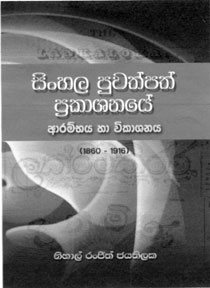 |
|
Sinhala Puwath path
Prakashanaye Arambhaya Ha Vikashanaya
Author:
Nihal Ranjith Jayatilaka |
The scholastic publication entitled "Sinhala Puwathpath Prakashanaye
Aarambhaya saha Vikashanaya" (The Origin and Evolution of Sinhala
Newspaper Publication) written by Dr. Nihal Ranjith Jayatilake, who is a
Deputy General Manager of the People's Bank as well as an author and a
freelance-journalist, will be launched at 4.00 p.m. on September 23 at
the auditorium of the Sri Lanka National Library Services Board, Nidahas
Mawatha, Colombo 7. The book is based on the thesis compiled by him for
his Ph.D.Degree awarded by the University of Sri Jayewardenepura.
In compiling the book Dr. Jayatilake says 77 main stream Sinhala
newspapers from "Lanka Lokaya" published in 1860 and considered as the
first Sinhala newspaper in the country and publications of "Dinamina"
newspaper up to 1916 (56 years), have been comprehensively scrutinized
for their contents.
The book is an investigative study of economic, social and religious
background that impacted upon the Sinhala newspaper publication. Early
English and Tamil newspapers originated before Sinhala newspapers. A
special feature of the book is the inclusion of the origin of newspapers
in the world and a number of historical information relating to
international trends which have not yet been included in any Sinhala
book.
Ven. (Prof) Bellanwila Wimalarathana Thera, Chancellor of the
University of Sri Jayewardenepura, will preside over the launching
ceremony of the book and the Chairman of the People's Bank W.
Karunajeewa will be the chief guest. Prof. Sunanda Mahendra, Prof.
Ganganath Dissanayke, Dr. Praneeth Abeysundara and Gamini Sumanasekera
will deliver brief discourses on the publication. Samudra Wettasinghe
will compere the program.
Copies of the book will be presented to all editors of national
Sinhala newspapers. The book is a Sarasavi publication.
The splendour of Sri Palee
 A compendium entitled "The splendour of Sri Palee", to mark the 75th
anniversary of Sri Palee College, Horana will be launched on September
24 at the College premises under the auspices of the Indian High
Commissioner Aloka Prasad. A compendium entitled "The splendour of Sri Palee", to mark the 75th
anniversary of Sri Palee College, Horana will be launched on September
24 at the College premises under the auspices of the Indian High
Commissioner Aloka Prasad.
The special launching ceremony is organised by the Colombo Branch of
Sri Palee Past Pupils Association with the help of the present principal
J. D. L. V. K. Jasinghe, teachers and present students.
Edited by a special panel comprising past pupils this special
compendium portrays the thoughts and deeds of its founder the late
Wilmot A. Perera, inspiration and influence of Indian poet Rabindranath
Tagore, the unique educational activities of Sri Palee and unforgettable
memories of the past.
Guru Maha Dasava

Jayakody Seneviratne's latest anthology of short stories entitled
'Guru Maha Dasava' will be launched at Dayawansa Jayakody Book
Exhibition Hall,Ven. S. Mahinda Mawatha, Colombo 10 on September 21 at
10 am.
Award-winning author Jayakody Seneviratne's earlier books include 'Kumarihami,
Loky Putha, Vajirapani, Pancha Kalyani, Athavesiyo, Sudu Rukada, Ran
Tharuva, Rubara Doni, Hithuvakkari, and Ridi Sela.'
"Guru Maha Dasava" is a Dayawansa Jayakody publication.
Vilibiya
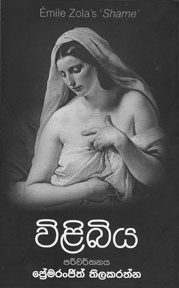
Vilibiya is the Sinhalese translation of Emile Zola's 'Shame' by
Premaranjith Thilakaratne. This perceptive novel will be a good read for
discriminating Sinhala readers. The author Premaranjith Thilakarathne is
a bilingual and gifted translator. His literary works include ' Kingdom
of Liars', a social satire in English.
Nava Sinhala Viyakaranaya -01 (History of Sinhala)

Nava Sinhala Viyakaranaya is a first of the series of publications by
Prof. Sucharitha Gamlath on Sinhala grammar. The first of the series
explores the history of Sinhala language and how many other languages
influenced Sinhala.
Julius Caesar
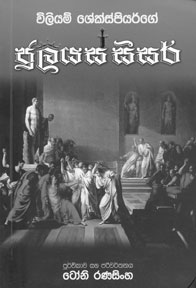
Julius Caesar is the Sinhalese translation of Shakespeare's Julius
Caesar by Tony Ranasinghe. The book is the unabridged Sinhalese
translation of the celebrated play of the Bard.
BOOK LAUNCH
Manthri Hatana
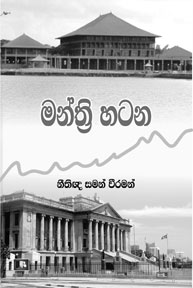
Saman Weeraman's book 'Manthri Hatana' was launched at the
International Book Faire at the BMICH Yesterday.
New arrivals
|

